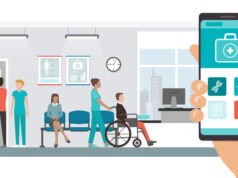Healthcare Design interviewed four leading product designers who shed light on the healthcare challenges they’re working to solve and the inspiration that guides them. Here, Tara Rae Hill from LittleFish Think Tank shares her story.
 Name: Tara Rae Hill
Name: Tara Rae Hill
Position: creative director, founder, LittleFish Think Tank
Location: Atlanta
Years working in design: 27
Years in current role: 12
Product categories: textiles, furniture, solid surfaces
Market segments: healthcare, corporate, hospitality, residential
Healthcare Design: Share a little about your professional background and what drew you to a career in design.
Tara Rae Hill: In a nutshell: I love design. It solves issues and provides people with happiness. It’s magical! My design beginnings were underway in early youth, thanks to my dad, who’s an architect. I was exposed to construction sites, ink drawings and drafting boards, and blueprint machines. I also had a thriving ceramic business as a kid. Beginning to draft before graduating high school, I made a natural transition to design school. I graduated with a Bachelor of Fine Arts degree in interior design. Then, I pursued a career practicing full-scope interior design.
How did you become interested in product design, specifically?
After 16 years of many stressful, fast-paced interior projects, with many late nights/weekends spent at the studio, I was acutely aware that our time expenditures and professional successes foundationally rested on locating the perfect product offerings. I’m committed to the human experience and operational requirements of space design. Those requirements can only be answered with appropriate product choices. Searching for products combined with wanting expressive color applications, my journey with designing products has been a long-standing practice of sleuthing ways to satisfy manufacturers’ custom quantity requirements to then redesign their running-line products for my space designs. Slowly, I became well-known as the “tinkerer of products.”
Tell us about your current role.
LittleFish Think Tank, by design, is a highly collaborative boutique design firm. We design in all market segments with a focus on healthcare and, to date, have designed a plethora of product types: woven upholsteries, vinyl, glass, carpet, solid surface, quartz, plastics, and furniture. As the founder and creative director, my role is simply put: “the chick that gets it done!” I lead all aspects of our projects from programming to visioning, design ideation, and on through product storytelling and launching pieces. I also want our manufacturers to have successful outcomes, so I work closely with their marketing and sales teams to ensure all closed loops.
Describe the first time you worked on a healthcare product. What did you learn from that process/experience?
My introduction to health-related products for formal market launch began with a surprise call from Dupont Building Innovations, which resulted in their Healing Colors Collection of solid surfaces for healthcare. Dupont’s primary goal was to be the “go-to solid surface resource” for healthcare specification. Their proposed scopes were dreamy and included designing with color’s contributions for health (I have a strong background in color theory) and evidence-based design tenets. Dupont taught me the power of master planning and knowing where you want to land and that well-designed products do not sell themselves—they require well-executed, uniquely timed, and fashioned marketing and sales initiatives.
How is healthcare different from other sectors?
The biggest challenge with all design projects, and heightened in healthcare, is the need to strike the perfect balance between securing the objective functional needs and still delivering subjective experiential elements. The human touch points are what users feel, see, and respond to. This could be as tangible as a chair’s comfort or more abstract as the joy of a color palette, the soft touch of an upholstery, and increased confidence. I don’t find securing the functional aspects for healthcare, in and of itself, to be a great challenge. The challenge is not allowing those essential functional needs to cancel, or even notably compromise, the equal need for comfort, beauty, and visual order.
What challenges do you frequently hear from clients, and how are you working to solve them?
One most specific to healthcare product ideation is that product producers have a genuine interest to launch new products and gain exposure for them at high-activity trade shows. With healthcare’s heightened design challenges, combined with meeting the internal operational needs for mass production, healthcare products often require more process time within their conception, proofing, tooling, and prototype phases. The tail end of this process can easily be interrupted or sped up by a manufacturer’s need to launch at show dates. We always encourage getting a product swiftly through its ideation window and into a manufacturer’s domain for tooling and prototyping, where design aspects can still be massaged, knowing a trade show is always on the horizon.
What is the biggest healthcare-related issue on your radar right now?
As we venture closer to a post-antibiotic world with the rise of deadly, often invisible pathogens, their transmission via compromised surfaces (and poor detailing) remains a supreme issue. When surfaces harbor bacteria and mold or can’t be adequately cleaned, the consequences can range from death and illness to a 2 percent loss of medical reimbursements. Simply put, healthcare spaces are responsible for their occupants, and healthcare designers and product producers are responsible for the surfaces we deliver.
What inspires you? Give us a snapshot of your creative process.
I like to begin with understanding the root of problems and “chat ’em up” with clients and peers. Design is solving issues; making objects pretty is just one result. I typically start by lofty listenings, then I chew and madly pin to open my thought centers and percolate ideas. Then, I like the fluidity of freehand sketching, clay modeling, and/or mood boards where the mind stays free of executive tasking. For final executions, this is always finessed in precision-based digital software.
Is there one healthcare product you’ve designed that stands out to you?
When designing IOA Healthcare Furniture’s 2011 NeoCon booth, I really wanted ordered seating social groupings. At that time, IOA was shy on occasional table offerings. Approaching company President Fabio Delmestri for how best to achieve this, he quickly cried,“Just design them!” I initially was confused. He explained they would produce any smart design I was willing to conjure up. This occurred a second time when we designed their booth for the 2011 Healthcare Design Expo & Conference. The Momo and Oliver Cantilever Tables were born, and so was my serendipitous entry into healthcare furniture design.
What do you hope to have the opportunity to design in the future?
I’m intrigued by where humans are headed with the Fourth Industrial Revolution and how the quest of design will skyrocket into a multidisciplinary approach using computer sciences, robotics, biotech, and aesthetics. The inherent meanings of “design” or “designer” are on the fringe of enormous change. I’m genuinely enthused when I interact with emerging professionals graduating in design and tech-based programs and salivating at [what they] will advance for humankind and our planet in the decades to come.
Jennifer Kovacs Silvis is editor-in-chief of Healthcare Design. She can be reached at jennifer.silvis@emeraldexpo.com.







